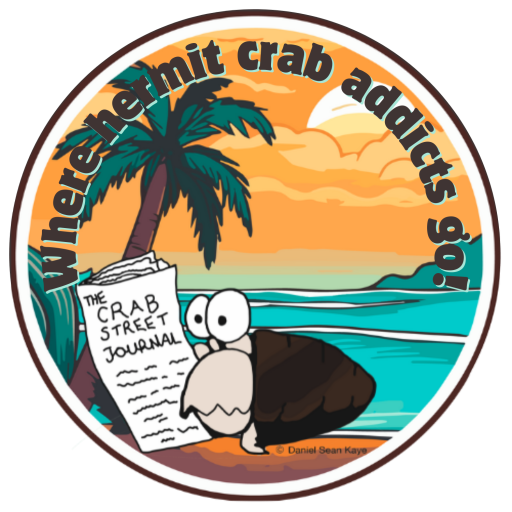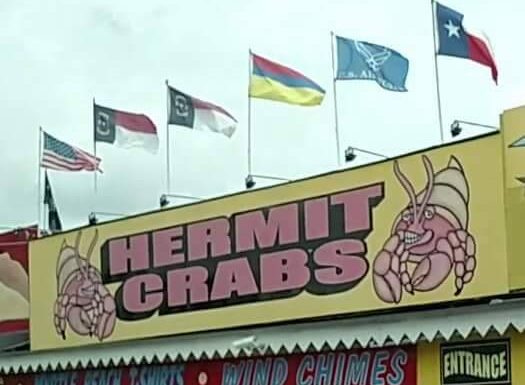written by Rose Marie Senary
If you’ve ever gone on vacation to a beach destination, there is a good chance you have encountered a beach shop with a cage or cages full of hermit crabs. There is also a good chance that you’ve found yourself compelled to bring one home. Why not? They’re hard to resist. They come in beautiful shells of all different colors and sizes. Their exoskeletons have varying degrees of purple, red, brown, lavender, and if you’re lucky—a strawberry red. Their sizes range from micro to jumbo. You can find them at just about every beach shop, pet store, and even the occasional toy store. Hermit crabs have become a common vacation “souvenir” for many beach-going travelers. They are marketed as “easy” pets and sold in tiny plastic containers with rocks or small metal cages. Most people do not know the plight of the hermit crabs. Most people don’t know that these unsealed homes ensure a long painful death by suffocation due to the lack of necessary humidity required to keep their modified gills moist. The average beachgoer doesn’t know that the pellets and “hermit crab food” mixes typically sold with them are full of preservatives and other toxins. Some lucky hermit crabs have owners that stumble upon information on “proper care” upon returning home. Unfortunately, much of the information readily available online is incorrect and pet stores also fail to provide proper instructions—generally placing profit above survival. If the hermit crabs are truly lucky, their owner will find The Crab Street Journal/Land Hermit Crab Owners Society and care enough to make the changes necessary for them to not only survive—but also thrive.
It is the mission of the Land Hermit Crab Owners Society to not only educate the public on proper hermit crab husbandry, but above all to end wild capture and promote breeding programs instead. This is why we strongly discourage the sale/purchase of wild caught hermit crabs in favor of our international adoption program, adopting a captive bred baby hermit crab, or even rescuing local hermit crabs that are being given away for free on resale sites by owners who no longer want the responsibility of care.
In addition to proper care, it is imperative to also consider the environmental impact that harvesting large quantities of hermit crabs has on our beaches and wild hermit crab colonies as well as how our own human footprint impacts our oceans, beaches, and the hermit crabs. These wild populations need to be protected in order to preserve not only this species but also their natural environment that is home to many other creatures besides the hermit crabs. The government of Bermuda has put into place a plan to restore wild hermit crab populations to their native habitat. Several things contributed to the collapse of the population but the over collection of their preferred shell, the West Indian Topshell, played a large part.
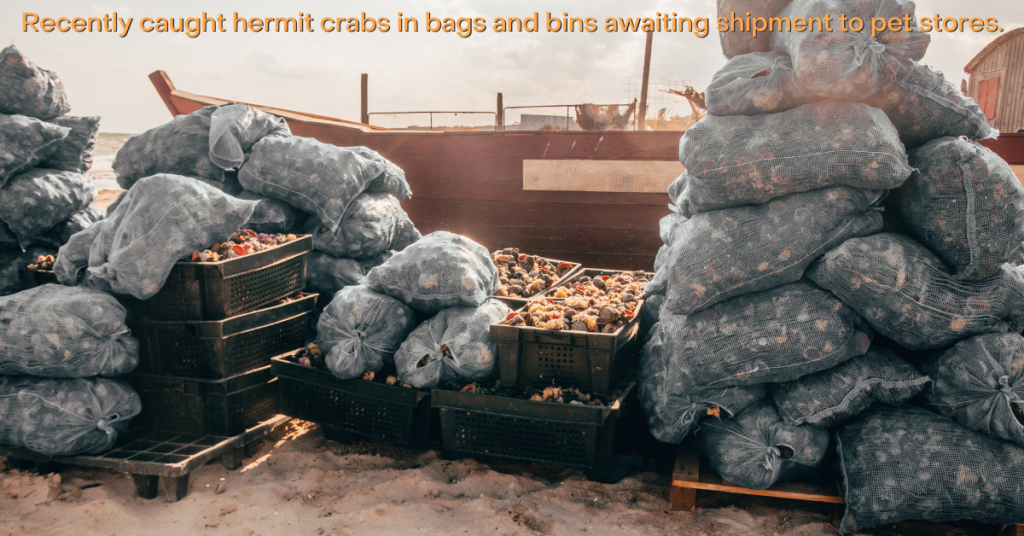
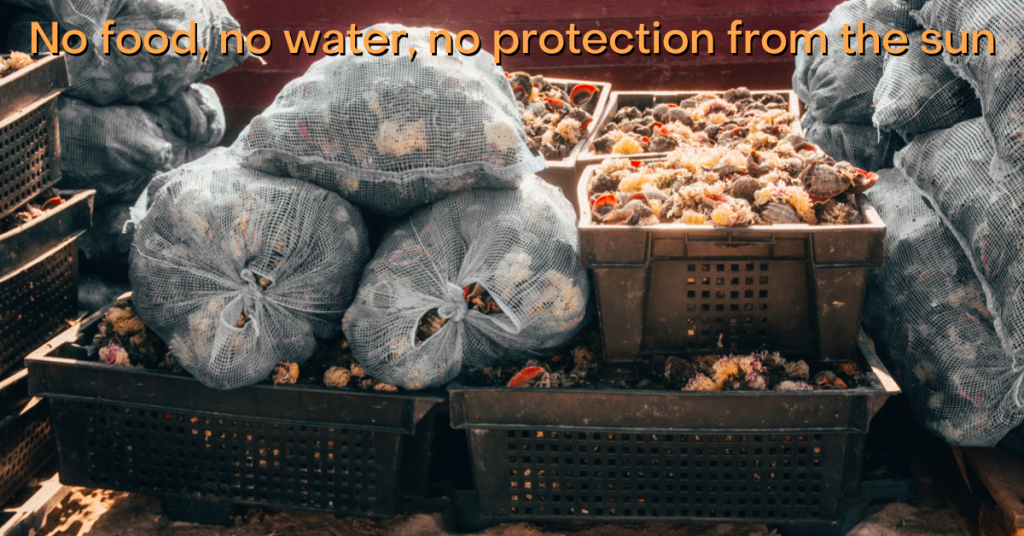
But, where do these intriguing creatures come from before we find them in their painted shells and colorful cages? The answer is horrifying and if the world knew what these poor creatures go through to get to those beach stands I truly believe they would be outlawed.
If your dog were shipped to you in a Chinese takeout box would it enrage you? If your cat was thrown in a box or bag with other cats and deprived of food and water for weeks would you protest? That is what happens to hermit crabs prior to their arrival at pet stores, beach shops, and other merchants around the world. Naturally, hermit crabs live in warm, humid environments like the Caribbean and Indonesia. They are harvested from their natural oasis and thrown into bags, bottles, and boxes. They are then taken to a warehouse of sorts and thrown with other bags and boxes of crabs into closet type rooms without food or water. Often, their shells are put into a vice and cracked off so they can be forced into painted shells. Occasionally, the paint isn’t quite dry and their exoskeleton becomes fused to their shell making it impossible for them to molt successfully or change shells.
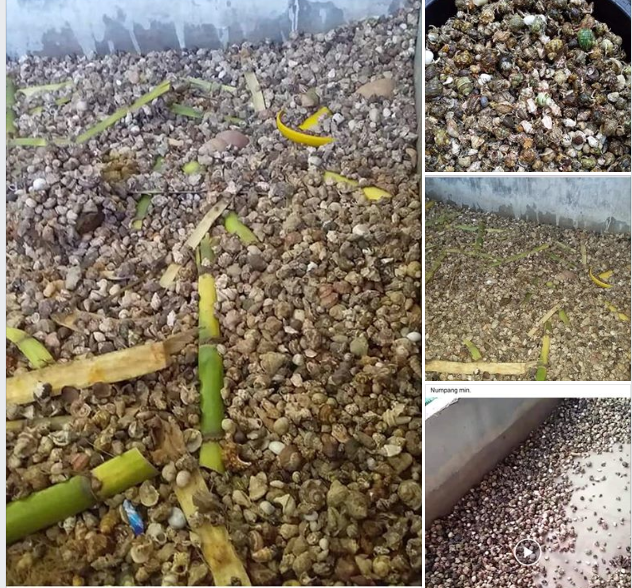
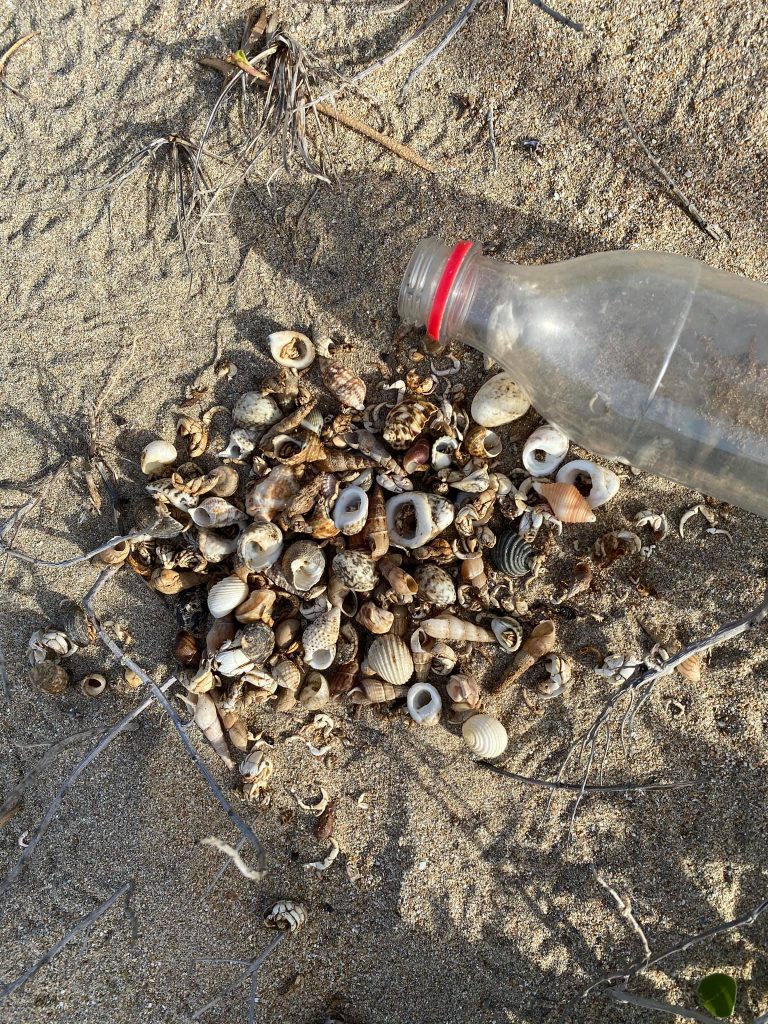
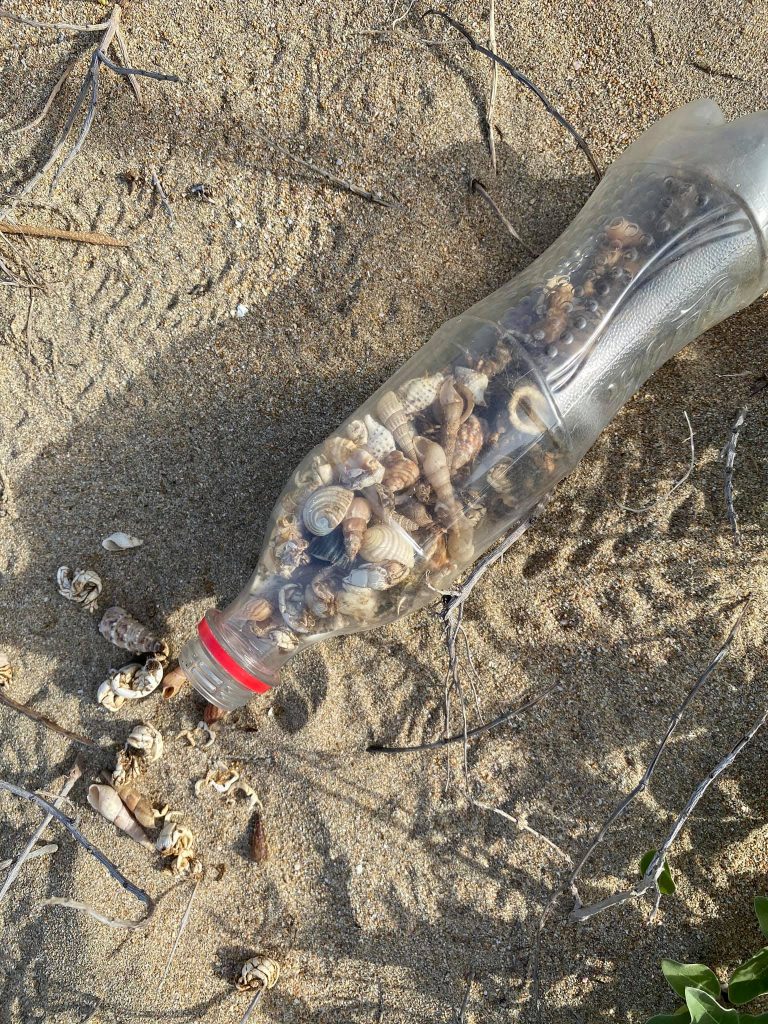
Next, they are once again thrown into packages, together, sometimes with no protective shipping materials. By now they are dehydrated and starving. They lose legs and pinchers due to the stress. Survival instincts kick in and cannibalism begins. They are shipped overseas to countries all across the globe without proper heat or humidity. Distributors stuff them into takeout boxes and then ship them to their final merchant destinations. By the time you see them they have been through more than many can recover from. They are put into inadequate habitats as they wait to be purchased. Many don’t survive. More lose limbs. If they are given food and water at this point, it is toxic pellets that slowly kill them over time and untreated water with a bacteria-breeding sponge in the middle of it. Their water isn’t deep enough to rehydrate their abdomen—a necessary act for survival. Their food lacks the proper nutrition to support a molt. Their heat and humidity levels are far too low for their gills and systems to function properly. They become sick and sluggish. Their substrate is made from wood chips, too much/too wet eco earth, rocks, or nothing at all. They cannot bury to molt and even if they were able, chances of survival are slim because they have been deprived of the proper sustenance to ensure success. Many never leave the shop. It is their final resting place. The majority of the crabs that do make it to purchase are sent home with people who know little if anything about proper hermit crab husbandry. When they leave the store, they are once again put into habitats that lack the basic requirements for survival. Most will eventually die from Post Purchase Death Syndrome. Some will change homes multiple times as owners will tire of them or realize that they were not prepared to give them all that is required for survival. Only the very lucky few will end up in the homes of people who find The Crab Street Journal and the Land Hermit Crab Owners Society and are willing to do all they can to give them all they need to live the rest of their days happily, thriving. These are people who are constantly learning and are willing to put the needs of their crabs above their own desires for esthetics or keeping. These are the people who are making a difference and who will help change the way the world views these amazing creatures.
But, what about the merchants that sold the hermit crabs? They need to replace their inventory; therefore, MORE crabs are harvested from the wild to replace the ones that have died or been purchased and the cycle repeats itself! The merchants continue to offer improper care guidelines and inferior, toxic products. A business centered only on profit isn’t going to tell you what you need to know to keep your hermit crab (that could live 40+ years in captivity if cared for properly) alive. They want you to have to come back and purchase another crab. Your well-intentioned “rescue” attempts are great for business. Especially if you buy them out at the end of the season. They want you to buy their kits, incorrect shells, and all of the pellets, solutions, conditioners, vitamins, etc. that they peddle to make a buck. If you knew that just a few simple products could make your crab happy, healthy, AND save you money you wouldn’t need to keep going back to the pet store to spend your hard-earned cash. To most merchants, they are throwaway pets. Sometimes literally! Some merchants LITERALLY throw away hermit crabs at the end of “the season.” It is appalling!

In addition to over-harvesting, humans contribute to the demise of hermit crabs in other ways. Hermit crabs are scavengers and they aid in keeping our beaches clean by eating decaying matter such as fish, fruit, and plants. Coastal golf courses and resorts create fertilizer and pesticide runoff that leads to deadly bacterial blooms. This contamination is destroying the tide pools where many organisms are born. Polluted oceans and tide pools mean that hermit crabs are consuming toxic chemicals. Plastic use has increased drastically in the past several decades and remains on the rise. A United Nations report stated that according to their figures, “ there will be more plastic than fish in the world’s oceans by 2050 unless people stop using single-use plastic items such as plastic bags and plastic bottles.” Plastic attracts marine animals and wildlife (particularly sea birds and fish) and not only does it enter their stomachs upon consumption, but it also enters the food chain. The problem compounds itself when other predators eat those who have consumed plastic. Aside from the solid consumption issue, debris can absorb organic pollutants from seawater, including PCBs*, DDT**, and PAHs***. In addition to consuming plastic, hermit crabs have adapted to wearing trash instead of shells. Whether this is a survival tool and/or as a result of a shell shortage due to over-collection is unknown, but one thing is clear― our plastic is negatively affecting hermit crabs and other marine life.

Plastic affects hermit crabs in ways other than by consumption. Science Focus states that “more than half a million hermit crabs have been killed by becoming trapped in plastic debris on two remote islands.” For example, studies led by the Institute for Marine and Antarctic Studies (IMAS) at the University of Tasmania and researchers from London’s Natural History Museum and the Two Hands Project community science organization have revealed that Cocos and Henderson Islands are littered with millions of pieces of plastic. These piles of plastic pose a consumption risk as well as a daunting, physical barrier full of hazards and traps. Since hermit crabs do not create their own shells, they are forced to seek larger homes as they grow. Traversing these dangerous piles often causes a chain reaction. A hermit crab attempts to navigate through the plastic, gets trapped, and ultimately dies. When a hermit crab dies, it emits and odor that alerts other hermit crabs that there is an available shell. Because of this, one trapped crab could cause the death of many. Hermit crabs play an important role in tropical environments by aerating and are also a key part of marine nature systems. Researchers warn that losses of hermit crabs on a global scale would cause problems for ecosystems.
In Okinawa, plastic waste is so pervasive hermit crabs are wearing trash when suitable shells are not available.
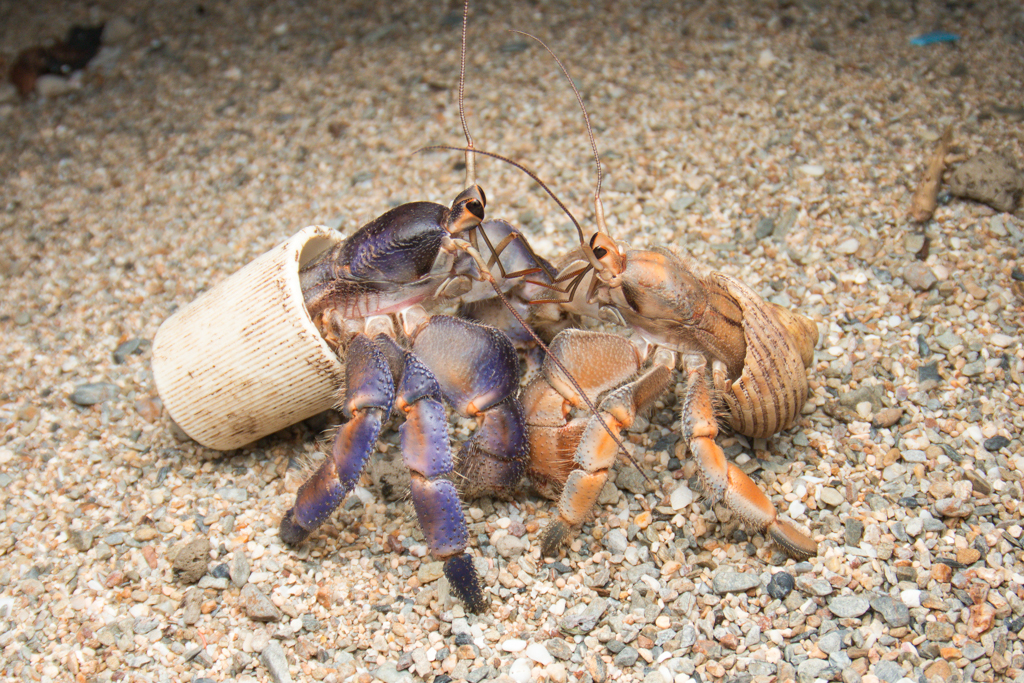
https://www.instagram.com/p/BcZWYtmnY3W – Shawn Miller on Instagram
In addition to plastic pollution, humans are pumping more and more carbon dioxide and other greenhouse gases into the atmosphere. This increase in CO2 is creating an increase in carbonic acid in the ocean. Carbonic acid “threatens marine organisms that have shells or skeletons made from the compound calcium carbonate.” As the hermit crabs grow they must find larger and larger shells to live in. These shells come from dead gastropods such as snails, slugs, and mussels. To create crystals of calcium carbonate, many sea creatures collect calcium ions and carbonate ions from seawater. Corals, for instance, use calcium carbonate to make skeletons, whereas other creatures, including snails, clams, and mussels, create shells. A more acidic ocean can interfere with this shell or skeleton-building process.
For Animals, Plastic Is Turning the Ocean Into a Minefield
https://www.nationalgeographic.com/magazine/2018/06/plastic-planet-animals-wildlife-impact-waste-pollution/
From getting stuck in nets to eating plastic that they think is food, creatures worldwide are dying from material we made.
BY NATASHA DALY
The plight of hermit crabs is similar to the plight of many other wild species that are currently endangered or threatened, in that humans are their biggest threat. Together, through conservation and education, we can rewrite the ending of the land hermit crab’s story. It is not too late to reverse the damage done and to allow wild populations to thrive in safety. In addition to our efforts here in the United States, others around the world are stepping up to be the voice of the humble hermit crab. Hobbyists are taking up the challenge of captive breeding. Academics are studying the species with a renewed interested in their important role in our ecosystem. In Taiwan, the black market hermit crab pet trade is been replaced with Eco Tourism, putting sellers in the position of tour guides. A practice we hope will continue to spread throughout the land hermit crab’s native regions. In Thailand, a private reserve has been created and wild caught hermit crabs are being released back into the wild with protection from recapture, safe from the pet trade.
My call to action: Be the change we want to see in the world.
- Resist the urge to purchase wild caught hermit crabs. Purchasing one, even under the best intentions, sentences another to death. It is tragic and unfair.
- Support and utilize our international Hermit Crab Adoption Program! There are hundreds of crabs all over the world waiting for their forever home.
- Do not collect shells from the beach. Without a suitable supply of empty shells hermit crab populations dwindle.
- Support the breeding efforts of our members, like Mary Akers, by donating funds, supplies, or if you are local to them— time. Their success is a success for us all! We cannot change laws to protect hermit crabs without offering a viable solution. Captive bred hermit crabs ARE the solution.
- Support The Crab Street Journal and Land Hermit Crab Owners Society and Stacy Griffith’s efforts to travel and bring education and awareness to people all over the United States by shopping at The Crab Street Market, the Land Hermit Crab Owners Society online store, or making a donation.
- If you are a teacher, participate in the Claws for Classrooms program. Education of children and youth is vital to changing the way hermit crabs are viewed as often it is the children who beg for a hermit crab while on vacation.
- Go to Crab Con and invite others to join you! This event is an outstanding way to educate not only our own members but also the public.
- Use the free resources available on The Crab Street Journal. Print the forms and take them to your local pet stores and beach shops.
- Write to your local pet shops and larger corporations, urging them to make changes in how they keep hermit crabs and the information they give to new owners.
- Post information from The Crab Street Journal and Land Hermit Crab Owners Society on social media, most people know nothing about the plight of the hermit crabs.
The world is starting to notice the injustice. Together we can stop the harvesting of wild hermit crabs if we each do our part. For more information, please visit LHCOS.org.
References
- Center for Disease Control. 2017. Polycyclic Aromatic Hydrocarbons (PAHs) Factsheet. https://www.cdc.gov/biomonitoring/PAHs_FactSheet.html
- Eisler, R. 1998. Copper hazards to fish, wildlife, and invertebrates: a synoptic review. U.S. Geological Survey, Biological Resources Division, Biological Science Report USGS/BRD/BSR–1997-0002. 98 pp. https://citeseerx.ist.psu.edu/viewdoc/download?doi=10.1.1.850.7220&rep=rep1&type=pdf
- Egloff S, Pietsch C. 2018. Ethoxyquin: a feed additive that poses a risk for aquatic life. Dis Aquat Org 131:39-48. https://doi.org/10.3354/dao03279
- Environmental Defense Fund.
http://seafood.edf.org/pcbs-fish-and-shellfish - Environmental Protection Agency. 2017. DDT – A Brief History and Status.
https://www.epa.gov/ingredients-used-pesticide-products/ddt-brief-history-and-status - European Food Safety Authority. 2010. Conclusion on the peer review of the pesticide risk assessment of the active substance ethoxyquin.
http://onlinelibrary.wiley.com/doi/10.2903/j.efsa.2010.1710/ - Griffith, S. 2021. www.crabstreetjournal.org
- McElroy B. 2001. Petition for copper sulfate in crop production – To add another annotation. California Certified Organic Farmers http://www.ams.usda.gov/AMSv1.0/getfiledDocName=STELPRDC5067032&acct=nopgeninfo
- McNamar, A. 2019. Science Focus News: Plastic Pollution Killing More than 500,000 Hermit Crabs on Remote Islands. https://tinyurl.com/y7lvppxj
- Science Direct. 2021. Immunology and Microbiology: Ethoxyquin.
https://www.sciencedirect.com/topics/immunology-and-microbiology/ethoxyquin - United Nations. 2017. UN: #CleanSeas campaign aims to combat marine plastic litter. https://youtu.be/QTaADoOKqQY
- United States Department of Agriculture, National Organic Program, Technical Service Branch, Technical Evaluation Report. 2011. Copper Sulfate and Other Copper Products Crops For Use as Plant Disease Control and For Use as Algicide and Invertebrate Pest Control. https://www.ams.usda.gov/sites/default/files/media/Coppers%20fixed%20TR%202011.pdf
- Wendel, J. 2016. EOS: Tide Pools Mimic Climate Change in Everyday Cycle. https://eos.org/articles/tide-pools-mimic-climate-change-everyday-cycle
- Entrapment in plastic debris endangers hermit crabs Jennifer L.Lavers Paul B.Sharp Silke Stuckenbrock Alexander L. Bond https://doi.org/10.1016/j.jhazmat.2019.121703
- https://www.facebook.com/LHCR-Bangkok-Land-Hermit-Crab-Rescue
“As noted in the 2001 petition for copper sulfate used as algicide and for tadpole shrimp control (McElroy, 2001), copper sulfate does kill algae and crustaceans.”
